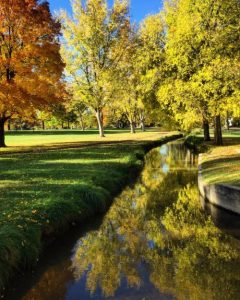Denver, a city known for its vibrant green spaces and bustling cityscape, owes much of its verdant charm to a historic marvel that many might not know about – the City Ditch. This ancient irrigation system, which turned what was once a dusty and desolate land into a flourishing urban oasis, carries a story worth exploring. From its early struggles to its successful transformation of the Denver landscape, the City Ditch represents an integral thread in the fabric of the city’s history.
The evolution of Denver through the waters of the City Ditch began in the early 1860s when attempts to green the city were challenged by the flat and arid landscape. The Capitol Hydraulic Company’s first attempt to construct the ditch failed disastrously. Undeterred, the company regrouped and in 1864, initiated another attempt that successfully directed water from the South Platte at Chatfield Reservoir to Denver. By 1867, the City Ditch, also known as Smith’s Ditch or Smith’s Irrigation Ditch, was operational, marking the beginning of a green revolution that would transform Denver into the leafy city it is today. This landmark achievement is celebrated as the oldest functioning piece of infrastructure within the city, predating even the city’s railroads and paved streets.
Despite most of City Ditch now being buried and piped except for the iconic open section in Washington Park, its legacy continues to resonate through modern Denver. This historic segment not only adds to the aesthetic appeal of the park with its footbridge-spanned waterways but also serves as a testament to the city’s ingenious solution to its early water distribution challenges. City Ditch has undergone significant transformations, including facing interruptions by highway expansions and adapting to the inclusion of recycled water to continue its service to the community. Today, it fills lakes and irrigates the lush landscapes of Washington and City parks, maintaining its role as a vital source of sustenance for Denver’s greenery.

source: Only in Denver: City Ditch, Denver’s Oldest Working Thing | VISIT DENVER Blog
Denver’s commitment to preserving its historical resources is evident in the ongoing relevance of City Ditch to the city’s landscape and heritage. This remarkable piece of history not only highlights the innovative spirit of Denver’s early settlers but also serves as a symbol of the city’s dedication to sustainability and beautification. The monument dedicated to John W. Smith and the laborers who created City Ditch by hand near Smith Lake in Washington Park is a fitting tribute to their contribution. As Denver continues to grow and evolve, the tale of City Ditch reminds us of the importance of harmonizing city development with environmental stewardship and respect for our shared history.
In wrapping up, the story of City Ditch is more than just a chapter in Denver’s developmental saga; it’s a narrative of resilience, innovation, and community spirit. It underscores how vital infrastructure, no matter how old, can continue to impact the lives of city residents positively, making Denver a model for cities worldwide in leveraging their historical assets for communal benefit. For locals, prospective residents, and business owners alike, knowing the story behind Denver’s greenery adds a layer of appreciation for the city we call home and its remarkable journey from a barren landscape to an urban haven.
